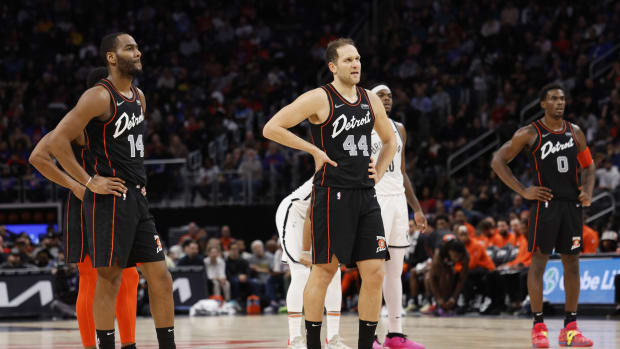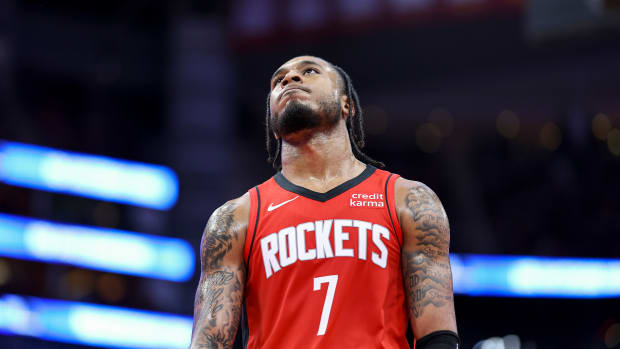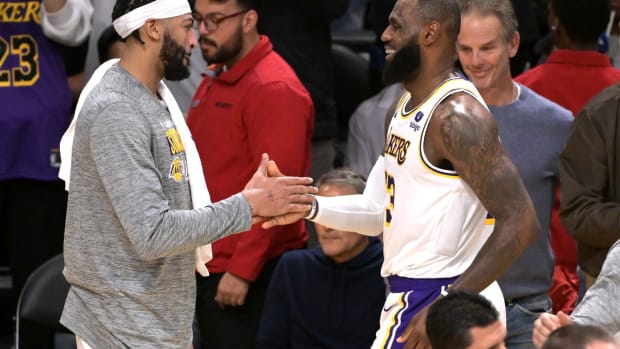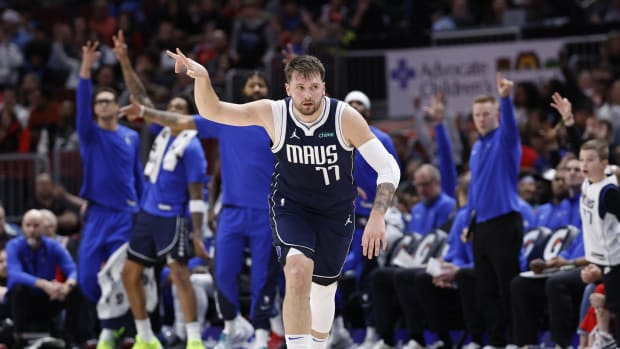How Chandler Parsons Could Be Compensated Following Career-Threatening Car Accident
A car accident involving Atlanta Hawks forward Chandler Parsons has caused the 31-year-old former University of Florida star to suffer serious head and back injuries. It might also spark a legal fight over millions of dollars.
Information about the accident is contained in a press release issued by Morgan & Morgan, one of the nation’s largest personal injury firms. According to the release, Parsons retained attorneys John Morgan and Nick Panagakis in the aftermath of a terrible incident. Parsons, his attorneys note, was driving home from a Hawks practice at about 2 p.m. on Jan. 15 when he was involved in a three-car collision at a busy intersection in Atlanta’s Brookhaven neighborhood. The accident was allegedly caused by a drunk driver. This driver, whose name has not been released but is male, was charged with driving under the influence and cited for failure to yield while turning left. Alcohol was found in his car, and he apparently admitted to drinking.
The Atlanta-Journal Constitution has obtained the police report from the incident. It supplies additional details. The at-fault driver made a left turn into traffic, which precipitated the crash. Police found the driver knocked unconscious from the crash. Inside his car, police discovered a 7-Up bottle containing alcohol while “the heavy odor of alcohol” reeked throughout the vehicle. Neither Parsons nor the driver of the third car was cited by police. The report also indicates that Parsons declined to be taken by ambulance to a hospital for treatment.
According to his attorneys, Parsons suffered life-altering and potentially career-ending injuries in the crash. Traumatic brain injury, disc herniation and a torn labrum are among the injuries. The degree of injuries is graver than was assumed last week when the Hawks announced the placement of Parsons in the NBA’s concussion protocol due to whiplash caused by a car wreck.
As a contextual point, a press release issued by a law firm about a client should be viewed in the appropriate light. A law firm has ethical and professional duties to aggressively advocate—“zealously advocate," per the Model Rules of Professional Conduct—on behalf of a client. A law firm is not a neutral narrator of past events involving a client. None of this is to suggest that Parsons didn’t suffer the severity of injuries described by his attorneys or that he is in any way responsible for his injuries (or those of anyone else injured in the three-car wreck), but the fact pattern will be subject to greater scrutiny in the weeks and months ahead.
One certain fact that reflects favorably on Parsons is that law enforcement declined to cite him for violating a criminal statute or a traffic ordinance. The absence of legal fault helps to corroborate the narrative shaped by Parsons’s attorneys.
The rise and fall of Chandler Parsons’s NBA career
The NBA career of Chandler Parsons has two parts. They could be labeled “the good” and “the bad.” This point could become relevant should Parsons sue the driver. More on that below.
A second-round pick by the Houston Rockets in the 2011 NBA draft, Parsons vastly exceeded expectations during his first five NBA seasons. He proved to be a dynamic and reliable wing, first for the Rockets and then the Dallas Mavericks. Parsons was often praised for highly proficient three-point shooting (he connected on 41.4% of his three-point attempts in the 2015-16 season). He also battled ongoing knee issues, and his right knee underwent multiple procedures. Still, Parsons managed to play in 83% of his teams’ regular-season games from 2011 to 2016. He seemed poised to have a long and successful career.
The peak of Parsons’s NBA career likely occurred in the summer of 2016, when he became a free agent. It was at that time when the Memphis Grizzlies signed Parsons to a max four-year, $94 million guaranteed contract.
The Grizzlies would come to rue the signing. Unfortunately for Parsons—as well as for his Grizzlies teammates and coaches—his health and ability entered a downward spiral.
To that point, Parsons missed large segments of the 2016-17, 2017-18 and 2018-19 seasons with various injuries, including continued problems with his right knee and a torn meniscus in his left knee. Parsons appeared in only 95 regular-season games during that time, meaning he missed 61% of Grizzlies games. When available to play, Parsons also didn’t play particularly well. Both his field goal and three-point percentages plummeted. He struggled in other aspects of the game, too.
The Grizzlies traded Parsons last July to the Hawks in a deal for two other under-performing players, Solomon Hill and Miles Plumlee. The move created an additional $200,000 in salary cap space for the Hawks. They gave up a combined $25.3 million in salary for Parsons, who is being paid $25.1 million in the final season of his four-year deal. The trade also freed up a roster spot for the Hawks. In other words, the Hawks made the deal more for cap and roster reasons than for Parsons.
Parsons has played sparingly with the Hawks, who currently possess the NBA’s second-worst record (10-33). He has accumulated a total of just 54 minutes over five games, shooting a horrid 28% from the field. His latest injuries probably mean his season is over.
Legal and contract reasons for Parsons to ensure that blame falls exclusively onto the drunk driver
There are a number of reasons why it’s important for Parsons to establish that he is the victim of an unlawful act.
First, Parsons wants to prevent the possibility that he is deemed in any way at fault for the accident and subsequent injuries. Keep in mind, an accident involving three cars sometimes leads to a finding that multiple drivers were at fault. Such a possibility seems unlikely here. Law enforcement declined to cite Parsons. Also, the person found to be at fault was driving drunk. Still, if anyone else was injured in the accident, Parsons—who has earned over $100 million in his NBA career—could become a target for blame. The fact that law enforcement did not blame Parsons doesn’t automatically guarantee a jury would reach the same conclusion in a civil case.
With that in mind, Parsons has the final months of a lucrative NBA contract to protect. Paragraph 12 of the uniform player contract notes that an NBA player must refrain from “activities [that] may impair or destroy his ability and skill as a basketball player.” Players who disregard that warning and suffer substantial injuries can become at risk of losing their contracts. A finding of reckless driving by an NBA player could count as a dangerous activity. Again, this concern doesn’t appear to be relevant to Parsons given what is known about the accident. His inability to play for the remainder of the season shouldn’t trigger adverse contractual consequences.
Besides, the National Basketball Players Association would vigorously fight any attempt by a team to void a player’s guaranteed contract. To the extent teams have been able to exit a deal, the circumstances have been exceptional. They have also led to contract buyouts rather than contract terminations.
In 2004, for example, the Chicago Bulls and point guard Jay Williams negotiated a buyout after he was seriously injured in a motorcycle accident (riding a motorcycle is prohibited under paragraph 12). Williams was reportedly paid $3 million of a deal that had $7.7 million remaining. That same year, the Boston Celtics agreed to pay Vin Baker $16 million of the $35 million remaining on his contract. Baker had struggled with alcohol issues and failed to report to practices. More recently, in 2015, Larry Sanders and the Milwaukee Bucks negotiated a settlement whereby the team agreed to pay him $22 million on a deal that had $44 million remaining. Sanders wished to step aside from his NBA career as he dealt with anxiety and other health issues. Neither Parsons nor his representatives want to provide any plausible opening for the Hawks to seek to terminate a contract that still owes him millions of dollars.
Second, Parsons wants to prevent any companies with which he has signed endorsement deals from using his situation to his detriment. During his NBA career, Parsons has signed endorsements with Nike and the Chinese brand Anta, among other companies. Any brands that currently pay Parsons for his sponsorship might be displeased with his disappointing play and general unavailability in recent seasons. Endorsement deals with established brands usually contain “morals clauses.” These clauses allow the endorsed company to terminate or suspend the contract if the player engages in controversial conduct. Parsons’s attorneys establishing that their client is a victim ensures that no such clause could be invoked.
Third, Parsons may have at some point purchased permanent total disability insurance policy (the Hawks might have obtained a similar insurance policy on Parsons’s contract). This type of insurance contemplates a player suffering a career-ending injury. Should the injury manifest, the player is paid a lump sum of money. These policies sometimes contain language that limits or denies payment when the policyholder is responsible for his or her own injuries through misconduct.
As described by his attorneys, the injuries that befell Parsons could end his career. A herniated disc, for example, can lead to long-term or permanent nerve damage felt in one’s arms, hands, legs or feet. If Parsons has purchased an insurance policy, he would need to submit to medical evaluations to assess the severity of his injuries and the validity of his claim.
Fourth, Parsons could sue the DUI driver for millions of dollars. Parsons could demand compensation for pain and suffering. He could also seek compensation for lost career opportunities that might have occurred after his contract expires at the end of the season. His ability to prove the severity of his injuries would be important. Attorneys for the DUI driver would attempt to downplay them and possibly highlight that Parsons declined to be transported to a hospital after the accident.
If a lawsuit ever went to trial, the value of Parsons’s future opportunities would invite conflicting expert testimony. Experts would likely include former team executives and agents paid to offer competing accounts of Parsons's basketball future.
On one hand, it’s possible that even if the crash hadn’t occurred, Parsons's NBA career would be over once his contract runs out this summer. As detailed above, Parsons has encountered a number of knee injuries in recent years. When healthy enough to play, Parsons hasn’t played well. To that point, it’s not a plus for Parsons’s attorneys that their client has played only 54 minutes for the NBA’s second-worst team this season.
Parsons is also 31, and he’ll turn 32 in October. Competition for NBA roster spots doesn’t get easier as players age. Each year a new set of talented and young players enter the pool of players competing for a finite number of spots with NBA teams. Meanwhile, players in their early-to-mid-30s often lose a bit of the athleticism that made them effective during their 20s.
On the other hand, some players rebound from injuries—particularly when their contracts are up. Had he not been injured in the car crash, perhaps Parsons would have dedicated himself over the summer to getting healthy. Also, even if his NBA career would have been over, he presumably could have still earned substantial income playing overseas, including in China or Europe. His attorneys would provide testimony and empirical data to that effect.
The ability of Parsons to establish that the DUI driver owes him millions of dollars and the ability of Parsons to collect any damages are two very different topics. While we don’t know much about the driver (other than that he appears to be completely irresponsible), most people don’t have millions of dollars saved and most don’t own homes worth millions of dollars they could sell to pay a seven- or eight-figure judgment. If the driver doesn’t have the money to pay Parsons, and if he doesn’t earn it in the years ahead, Parsons wouldn’t be able to collect money owed to him.
The driver’s automobile liability insurance is also not known. Georgia law requires that drivers carry auto insurance, with minimum limits of bodily injury liability of $25,000 per person and $50,000 per occurrence. Perhaps this driver has purchased enough insurance that his insurer would pay Parsons several hundred thousand dollars. Even then, the payout would not pay Parsons the value of the minimum NBA salary for a player of his experience ($2.3 million). Parsons might have also purchased an uninsured motorist insurance policy, which would provide him with additional compensation in the event that the driver lacks sufficient insurance. Whether he has such a policy, and how much it would pay, are unknown.
Michael McCann is SI’s Legal Analyst. He is also an attorney and the Director of the Sports and Entertainment Law Institute at the University of New Hampshire Franklin Pierce School of Law.


































